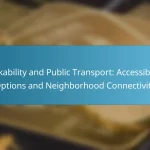What factors should you consider when choosing a neighborhood in Los Angeles?
When selecting a neighborhood in Los Angeles, consider safety, access to amenities, school quality, public transportation, and the community’s culture. Each of these factors can significantly impact your living experience and overall satisfaction in the area.
Safety and crime rates
Safety is a primary concern for many when choosing a neighborhood. Research crime rates through local police department websites or community safety apps to get a clear picture of the area’s safety. Generally, neighborhoods with lower crime rates are more desirable, but be sure to consider the context of the statistics.
Look for areas with active neighborhood watch programs or community engagement, as these can contribute to a safer environment. Additionally, visiting the neighborhood at different times can help you gauge safety levels firsthand.
Proximity to amenities
Access to amenities like grocery stores, parks, restaurants, and healthcare facilities can greatly enhance your living experience. Evaluate how close essential services are to your potential neighborhood, as this can save you time and improve your quality of life.
Consider creating a list of must-have amenities and their distances from potential homes. A neighborhood with a good mix of amenities within walking distance or a short drive can be more convenient and enjoyable.
School quality
If you have children or plan to in the future, the quality of local schools is crucial. Research school ratings through resources like GreatSchools or local education departments to assess the performance of schools in the area.
Additionally, consider the availability of extracurricular activities and special programs, as these can enrich your child’s education. A neighborhood with highly rated schools can also positively affect property values.
Public transportation options
Access to public transportation can be a significant factor, especially in a sprawling city like Los Angeles. Evaluate the availability of bus routes, subway stations, and commuter services that can connect you to your workplace or other parts of the city.
Having reliable public transit options can reduce commuting time and costs, making a neighborhood more appealing. Check transit schedules and routes to ensure they align with your daily needs.
Community vibe and culture
The community vibe and culture can greatly influence your happiness in a neighborhood. Spend time in the area to observe the local atmosphere, including events, social activities, and the general friendliness of residents.
Consider what type of community aligns with your lifestyle—whether you prefer a vibrant, bustling environment or a quieter, more laid-back atmosphere. Engaging with local community groups or attending neighborhood events can provide insight into the culture and help you feel more connected.
How do you evaluate safety in a neighborhood?
To evaluate safety in a neighborhood, consider crime rates, community programs, and local resources. Analyzing these factors will help you determine the overall security and livability of the area.
Crime statistics from local police
Crime statistics provide a quantitative measure of safety in a neighborhood. Local police departments often publish annual reports detailing incidents of various crimes, such as theft, assault, and vandalism. Look for trends over time, as a consistent decrease in crime rates may indicate improving safety.
When reviewing crime statistics, pay attention to the crime rate per 1,000 residents, which allows for better comparisons between neighborhoods of different sizes. Additionally, consider the types of crimes that are most prevalent, as some areas may have higher rates of non-violent offenses, which might not be as concerning.
Neighborhood watch programs
Neighborhood watch programs are community-driven initiatives aimed at enhancing safety through vigilance and cooperation among residents. These programs encourage neighbors to look out for one another and report suspicious activities to local authorities, fostering a sense of community and shared responsibility.
To assess the effectiveness of a neighborhood watch program, inquire about its structure, participation levels, and communication methods. A well-organized program with regular meetings and active involvement can significantly contribute to reducing crime and increasing residents’ sense of security.
What amenities should you look for in a neighborhood?
When choosing a neighborhood, consider amenities that enhance your lifestyle and convenience. Key amenities include parks, recreational facilities, shopping, and dining options, which can significantly impact your daily life and overall satisfaction.
Parks and recreational facilities
Parks and recreational facilities are essential for promoting an active lifestyle and providing green spaces for relaxation. Look for neighborhoods with accessible parks, walking trails, sports fields, and playgrounds, as these can enhance your quality of life.
Consider the size and condition of local parks. A well-maintained park with diverse amenities can serve as a community hub, while smaller or poorly kept parks may not meet your needs. Check for features like picnic areas, dog parks, and fitness stations to ensure they align with your lifestyle.
Shopping and dining options
Shopping and dining options are crucial for convenience and social interaction. A neighborhood with a variety of grocery stores, boutiques, and restaurants can save time and enhance your living experience. Look for areas that offer both local shops and larger retail chains to meet diverse needs.
Evaluate the distance to these amenities. Ideally, you want grocery stores and restaurants within a short drive or a reasonable walking distance. Consider the variety of cuisines and shopping experiences available, as well as the overall atmosphere of the dining and shopping scene, to ensure it fits your preferences.
How does school quality impact neighborhood choice?
School quality significantly influences neighborhood choice as families often prioritize access to high-performing educational institutions. A strong school district can enhance property values and provide a sense of community, making it a key factor in residential decisions.
School district ratings
School district ratings are essential indicators of educational quality and can vary widely across regions. Ratings are typically based on standardized test scores, graduation rates, and overall student performance. Families should research local school district ratings through resources like GreatSchools or state education department websites to gauge the quality of schools in potential neighborhoods.
When evaluating school district ratings, consider not only the overall score but also the specific strengths and weaknesses of individual schools. A district with a mix of high and low-rated schools may still offer valuable options, depending on your child’s needs.
Access to public and private schools
Access to both public and private schools is a crucial factor in neighborhood selection. Areas with a variety of educational options allow families to choose the best fit for their children, whether that be a public school with strong programs or a private institution with specialized curricula.
When assessing access, consider the proximity of schools to potential homes. A neighborhood with schools within a short driving distance or walkable routes can save time and enhance convenience for daily commutes. Additionally, check for enrollment policies, as some private schools may have waiting lists or specific admission criteria.
What are the best neighborhoods for families in Los Angeles?
Los Angeles offers several neighborhoods that are ideal for families, focusing on safety, schools, and community amenities. Some of the top choices include Westwood and Pasadena, each providing unique benefits for family living.
Westwood
Westwood is known for its family-friendly atmosphere, excellent schools, and proximity to cultural institutions like the Getty Center and UCLA. The neighborhood boasts a low crime rate and a variety of parks, making it suitable for outdoor activities and family gatherings.
Families can benefit from the strong community feel and access to educational resources. The area features diverse housing options, from single-family homes to apartments, catering to different budgets and preferences.
Pasadena
Pasadena is another great choice for families, offering a blend of historic charm and modern amenities. The city is home to top-rated schools and numerous parks, including the expansive Brookside Park, which provides playgrounds and sports facilities.
In addition to its educational advantages, Pasadena hosts family-friendly events throughout the year, such as the Rose Parade and various festivals. The housing market here includes a mix of bungalows and larger homes, appealing to families looking for space and community engagement.
How can public transportation influence your neighborhood choice?
Public transportation significantly impacts neighborhood selection by affecting commute times, accessibility, and overall convenience. Areas with robust transit options often attract residents seeking efficiency and connectivity to work, schools, and amenities.
Access to metro lines
Access to metro lines is a critical factor in choosing a neighborhood, as it often determines how quickly and easily residents can travel across the city. Living near a metro station can reduce commute times to under 30 minutes for many destinations, making it an attractive option for professionals and families alike.
When evaluating neighborhoods, consider the number of metro lines available and their coverage. A neighborhood with multiple lines offers greater flexibility and access to various parts of the city, while those with limited options may require longer travel times or additional transfers.
Bus routes and frequency
Bus routes and their frequency are essential components of public transportation that can influence neighborhood desirability. Frequent bus service, ideally with buses arriving every 10 to 15 minutes, can enhance mobility and reduce wait times, making it easier for residents to reach their destinations.
When assessing bus routes, check the coverage area and the proximity of stops to your potential home. A neighborhood with well-connected bus routes can provide access to key locations such as shopping centers, schools, and parks, which is particularly beneficial for those without a car.
What are the emerging trends in neighborhood selection?
Emerging trends in neighborhood selection focus on sustainability, community engagement, and accessibility. Many individuals prioritize areas that offer a blend of urban conveniences and green spaces, along with a strong sense of community.
Walkability and bike-friendliness
Walkability and bike-friendliness are crucial factors in neighborhood selection, as they promote healthier lifestyles and reduce reliance on cars. A walkable neighborhood typically features amenities within a short distance, such as grocery stores, parks, and public transportation options.
To assess walkability, consider the Walk Score, which rates neighborhoods based on proximity to essential services. A score above 70 is generally considered walkable, while areas scoring 90 or above are highly walkable. For bike-friendliness, look for dedicated bike lanes, bike-sharing programs, and overall cycling infrastructure.
When choosing a neighborhood, prioritize areas with a mix of residential and commercial spaces to enhance walkability and bike-friendliness. Avoid neighborhoods with heavy traffic or limited pedestrian pathways, as these can detract from the overall experience of living in a vibrant, accessible community.






